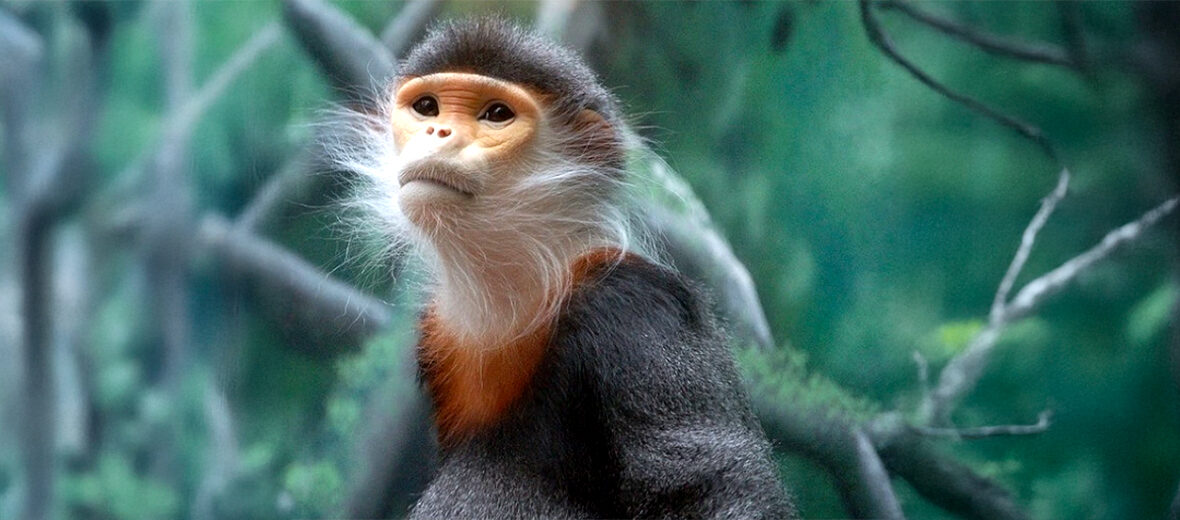
The grey-shanked douc langur is native to the Vietnamese provinces of Quảng Nam, Quảng Ngãi, Bình Định, Kon Tum, and Gia Lai. These primates face the on-going threats of habitat loss and destruction at the hands of residential and commercial developments; deforestation via the logging industry; roads and railroads that divide their territories and can result in vehicle strike (being hit by vehicles); hunting, for bush meat; and trapping, to be sold as pets and used in traditional medicine (like monkey balm). The IUCN lists these primates as Critically Endangered. Their increasingly fragmented populations are also decreasing.
First the Stats…
Scientific name: Pygathrix cinerea
Weight: Up to 24 lbs.
Length: Up to 24 inches, plus up to a 27 inch tail
Lifespan: Up to 24+ years
Now on to the Facts!
1.) These critters will sometimes mate and hybridize with red-shanked doucs.
2.) They are nocturnal (active at night).
3.) Grey-shanked doucs are also primarily arboreal (spend most of their lives in the trees).
4.) In the past these langurs had been found in troops as large as 50 individuals but those numbers have been drastically reduced to 4 – 15 individuals.
5.) Seeing as these primates function in a patriarchal society, males are the dominant gender and dominance hierarchies have been observed while in captivity.
But wait, there’s more on the grey-shanked douc langur!
6.) Communication is carried out via touch, visual communication, and sound. Growls are often used to show aggression. They can also be used as a threat or warning toward other individuals. A soft, twitter sound is utilized while being submissive.
7.) Like all primates, social grooming is carried out as a means of removing parasites and establishing and strengthening bonds between troop members.
Did you know…?
Up to 1,000 wild individuals existed as of 2016. As of 2024, only an estimated 700 remain.
8.) Individuals in the troop will also spar with one another. Sparring is a form of aggressive behavior where participants will grab, pull, and slap each other.
9.) Facial expressions include grimacing, which is used to show submissiveness, play face, which is used to play with other troop members, and staring which indicates either curiosity or aggression.
10.) Males will often times make faces at the females indicating that he is ready to copulate.
But wait, there’s still more on the grey-shanked douc langur!
11.) While primarily being folivores (eat leaves), these langurs will also feast on flowers, fruits, and seeds. This makes them an important part of their forest habitat as they will often disperse seeds, from the fruits they eat, via their feces (poop).
12.) Mating season lasts from August – December.
Did you know…?
In 2016 in the Central Highlands, gray-shanked douc Langurs were tragically tortured and murdered by Vietnamese troops who posted pictures of this horrific act online.
13.) Females undergo up to a 190 day gestation (pregnancy) they yields a single infant.
14.) Infants can weigh up to 25.4 ounces.
15.) Researchers have come to the conclusion that due to the major deforestation as well as climate change of their provinces of Vietnam, that the population of the grey-shanked doucs will drastically decline in the upcoming years.
16.) A long-term study in the Gia Lai Provence is currently being conducted as a part of the Frankfurt Zoological Society’s Vietnam Primate Conservation Program. This society also works with the Endangered Primate Rescue Center which currently has an ongoing Captive Breeding program.
Now a Short Grey-Shanked Douc Langur Video!
Be sure to share & comment below! Also, check out the Critter Science YouTube channel. Videos added regularly!

Want to suggest a critter for me to write about? Let me know here.
Some source material acquired from: Wikipedia & IUCN
Photo credit: Mungai and the Goa Constrictor



